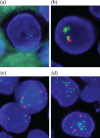Estrogen receptor alpha gene ESR1 amplification may predict endocrine therapy responsiveness in breast cancer patients
- PMID: 19320640
- PMCID: PMC11159263
- DOI: 10.1111/j.1349-7006.2009.01145.x
Estrogen receptor alpha gene ESR1 amplification may predict endocrine therapy responsiveness in breast cancer patients
Abstract
Estrogen receptor (ER) alpha plays a crucial role in normal breast development and has also been linked to mammary carcinogenesis and clinical outcome in breast cancer patients. However, the molecular mechanisms controlling the expression of ERalpha are as yet not fully understood. Gene amplification is one of the important factors regulating protein expression. Recent studies on the amplification of the ESR1 gene, which encodes ERalpha, have presented conflicting data. Using fluorescence in situ hybridization and real-time quantitative polymerase chain reaction analysis, we examined the ESR1 status in a series of breast cancer tissues and analyzed its clinical importance. ESR1 gene amplification and gain were found in 22.6 and 11.3% of samples, respectively, as determined by three-dimensional fluorescence in situ hybridization assay. Moreover, ESR1 amplification and amplification plus gain were significantly negatively correlated with tumor size, number of positive lymph nodes, negative ERalpha, and positive human epidermal growth factor receptor 2 status. It has also been shown that ESR1 amplification strongly correlates with higher expression levels of ER protein and that patients with ESR1 amplification in their tumors apparently experience longer disease-free survival than those without. Our data suggest that ESR1 amplification might prove to be helpful in selecting patients who may potentially benefit from endocrine therapy.
Figures




References
-
- Ricketts D, Turnbull L, Ryall G et al . Estrogen and progesterone receptors in the normal female breast. Cancer Res 1991; 51: 1817–22. - PubMed
-
- Allred DC, Mohsin SK, Fuqua SA. Histological and biological evolution of human premalignant breast disease. Endocr Relat Cancer 2001; 8: 47–61. - PubMed
-
- Herynk MH, Fuqua SA. Estrogen receptor mutations in human disease. Endocr Rev 2004; 25: 869–98. - PubMed
MeSH terms
Substances
LinkOut - more resources
Full Text Sources
Medical
Research Materials
Miscellaneous

